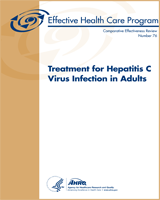NCBI Bookshelf. A service of the National Library of Medicine, National Institutes of Health.
Chou R, Hartung D, Rahman B, et al. Treatment for Hepatitis C Virus Infection in Adults [Internet]. Rockville (MD): Agency for Healthcare Research and Quality (US); 2012 Nov. (Comparative Effectiveness Reviews, No. 76.)
| Inclusion Criteria | |
|---|---|
| Populations | Asymptomatic adults with chronic hepatitis C virus infection who have not received antiviral drug treatment previously Subgroups include: HCV genotype, race, sex, stage of disease, viral load, weight, and others (e.g. genetic markers)
|
| Interventions | KQ 1a and b: 1a. What is the comparative effectiveness of antiviral treatment in improving health outcomes in patients with HCV infection? 1b. How does the comparative effectiveness of antiviral treatment for health outcomes vary according to patient subgroup characteristics, including but not limited to HCV genotype, race, sex, disease severity or genetic markers? KQ 2a and b: 2. What is the comparative effectiveness of antiviral treatments in improving intermediate outcomes, such as the rate of viremia, aminotransaminase levels, and histologic changes? 2a. How does the comparative effectiveness of antiviral treatment for intermediate outcomes vary according to patient subgroup characteristics, including but not limited to HCV genotype, race, sex, disease severity or genetic markers? KQ 3a and b: 3a. What are the comparative harms (including intolerance to treatment) associated with antiviral treatment? 3b. Do these harms differ according to patient subgroup characteristics, including HCV genotype, race, sex, disease severity or genetic markers? KQ 4: Have improvements in intermediate outcomes (viremia, liver function tests, histologic changes) been shown to reduce the risk or rates of health outcomes from HCV infection? |
| Comparisons | KQ 1a and b: 1a. What is the comparative effectiveness of antiviral treatment in improving health outcomes in patients with HCV infection? 1b. How does the comparative effectiveness of antiviral treatment for health outcomes vary according to patient subgroup characteristics, including but not limited to HCV genotype, race, sex, disease severity or genetic markers? KQ 2a and b: 2a. What is the comparative effectiveness of antiviral treatments in improving intermediate outcomes, such as the rate of viremia, aminotransaminase levels, and histologic changes? 2b. How does the comparative effectiveness of antiviral treatment for intermediate outcomes vary according to patient subgroup characteristics, including but not limited to HCV genotype, race, sex, disease severity or genetic markers? KQ 3a and b: 3. What are the comparative harms (including intolerance to treatment) associated with antiviral treatment? 3a. Do these harms differ according to patient subgroup characteristics, including HCV genotype, race, sex, disease severity or genetic markers? KQ 4: Have improvements in intermediate outcomes (viremia, liver function tests, histologic changes) been shown to reduce the risk or rates of health outcomes from HCV infection? |
| Outcomes | Clinical outcomes
|
| Settings | All settings (including primary care and specialty settings) and locales, though focus on studies conducted in the U.S. and other developed countries. |
| Study designs | KQ 3a and b: 3a. What are the comparative harms (including intolerance to treatment) associated with antiviral treatment? 3b. Do these harms differ according to patient subgroup characteristics, including HCV genotype, race, sex, disease severity or genetic markers? KQ 4: Have improvements in intermediate outcomes (viremia, liver function tests, histologic changes) been shown to reduce the risk or rates of health outcomes from HCV infection? |
- Hepatitis C Treatment: Inclusion Criteria by Key Question - Treatment for Hepati...Hepatitis C Treatment: Inclusion Criteria by Key Question - Treatment for Hepatitis C Virus Infection in Adults
Your browsing activity is empty.
Activity recording is turned off.
See more...
